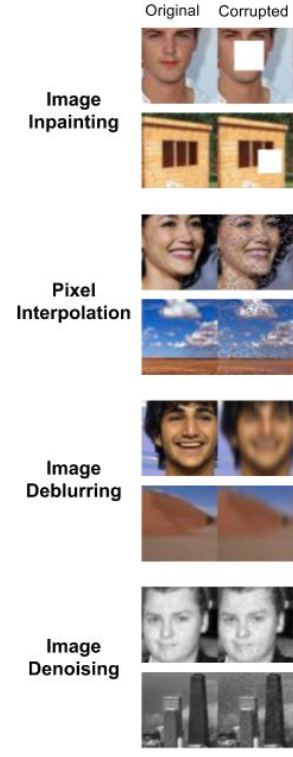Simple Baselines for Image Restoration
conference: ECCV2022 authors: Liangyu Chen, Xiaojie Chu, Xiangyu Zhang, Jian Sun, MEGVII Technology (曠視科技) github: https://github.com/megvii-research/NAFNet reference: https://arxiv.org/abs/2204.0467
Image Restoration
Image Restoration is a family of inverse problems for obtaining a high quality image from a corrupted input image. Corruption may occur due to the image-capture process (e.g., noise, lens blur), post-processing (e.g., JPEG compression), or photography in non-ideal conditions (e.g., haze, motion blur). Examples of Image Restoration:
Abstract
- Although there have been significant advances in the field of image restoration recently, the system complexity of the SOTA methods is increasing as well, which may hinder the convenient analysis and comparison of methods.
- In this paper, we propose a simple baseline that exceeds the SOTA methods and is computationally efficient.
- We derive a Nonlinear Activation Free Network, namely NAFNet, from the baseline.
Fig. 1: PSNR vs. computational cost on Image Deblurring (left) and Image Denoising (right) tasks. (Peak signal-to-noise ratio, PSNR) (Giga Multiply Add Caculation per Second, MACs)
Build A Simple Baseline
Architecture
- Inter-block Complexity are multi-stage networks, i.e. the latter stage refine the results of the previous stage, and each stage is a U-shaped architecture.
- To reduce the inter-block complexity, we adopt the classic single-stage U-shaped architecture with skip-connections, as shown in Figure 2c, following Restformer and Uformer.
Fig. 2: Comparison of architectures of image restoration models. Dashes to distinguish features of different sizes. (a) The multi-stage architecture[4,35] stacks UNet architecture serially. (b) The multi-scale fusion architecture[24,6] fusions the features in different scales. (c) UNet architecture, which is adopted by some SOTA methods[37,34]. We use it as our architecture.
Layer Normalization
- Although abandoned
Batch Normalizationas the small batch size may bring the unstable statistics, re-introduce the Instance Normalization and avoids the small batch size issue. - However, Hinet shows that adding instance normalization does not always bring performance gains and requires manual tuning.
- Based on these facts we conjecture Layer Normalization may be crucial to SOTA restorers, thus we add Layer Normalization to the plain block described above.
Activation
- The activation function in the plain block,
Rectified Linear Unit (ReLU), is extensively used in computer vision. However, there is a tendency to replace ReLU with GELU in SOTA methods [22,37,30,21,11]. - We replace ReLU with GELU in the plain block, because it keeps the performance of image denoising while bringing non-trivial gain on image deblurring.
Attention
- Inspired by Restormer, we realize the vanilla channel attention meets the requirements: computational efficiency and brings global information to the feature map.
- In addition, the effectiveness of channel attention has been verified in the image restoration task, thus we add the channel attention to the plain block.
Fig. 3: Intra-block structure comparison. ⊗:matrix multiplication, ⊙/⊕:elementwise multiplication/addition. dconv: Depthwise convolution. Nonlinear activation functions are represented by yellow boxes.
Nonlinear Activation Free Network (NAFNet)
- The baseline described above is simple and competitive, but is it possible to further improve performance while ensuring simplicity?
Fig. 4: Illustration of (a) Channel Attention[15] (CA), (b) Simplified Channel Attention (SCA), and (c) Simple Gate (SG). ⊙/∗: element-wise/channel-wise multiplication.
Simple Gate Unit
- Based on these, we propose a simple GLU variant: directly divide the feature map into two parts in the channel dimension and multiply them, as we shown in Figure 4c, noted as SimpleGate.
- The results demonstrate that GELU could be replaced by our proposed SimpleGate.
GAUSSIAN ERROR LINEAR UNITS (GELUS):

Simplified Channel Attention
- Channel Attention: it squeezes the spatial information into channels first and then a multilayer perceptual applies to it to calculate the channel attention, which will be used to weight the feature map.
- This inspires us to consider channel attention as a special case of GLU, which can be simplified like GLU in the previous subsection.
Experiments
The ablation studys are conducted on image denoising (SIDD) and deblurring (GoPro) tasks. We limit our computational budget to 16 GMACs (when input size is 256 × 256) in experiments if not specified, following.
Using metrics: (Peak signal-to-noise ratio, PSNR) (Structural SIMilarity, SSIM) (Giga Multiply AddCaculation per Second, MACs)
Table 1: Build a simple baseline from PlainNet. The effectiveness of Layer Normalization (LN), GELU, and Channel Attention (CA) have been verified. ∗ indicates that the training is unstable due to the large learning rate (lr)
Table 2: NAFNet is derived from the simplification of baseline, i.e. replacing GELU to SimpleGate (SG), and replacing Channel Attention (CA) to Simplified Channel Attention (SCA)
RGB Image Denoising
Fig. 5: Qualitative comparison of image denoising methods on SIDD.
Table 5: Image Denoising Results on SIDD.
Image Deblurring
Table 6: Image Deblurring Results on GoPro[25].
Fig. 6: Qualitative comparison of image deblurring methods on GoPro[25].
Raw Image Denoising
Fig. 7: Qualitatively compare the noise reduction effects of PMRID[33] and our porposed NAFNet. Zoom in to see details.
Table 7: Raw image denoising results on 4Scenes[33]

